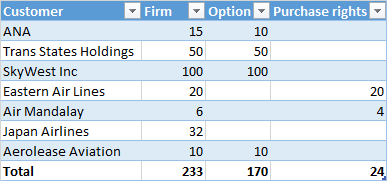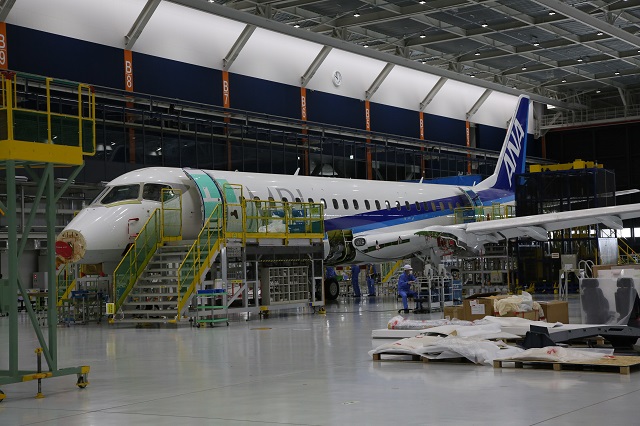Mitsubishi Aircraft brought its MRJ regional jet mock-up to the Farnborough air show in July 2016, the same one it displayed at Le Bourget in 2015. It held its usual mock-up tour to highlight the features of the Japanese aircraft, but most had seen it before, and it had lost its novelty value. But Le Bourget this year it will be different: the MRJ is set to steal the limelight, as it makes its debut at an international air show.
Some argue that taking a prototype out of its test schedule is an unnecessary distraction for the programme, one Mitsubishi can ill-afford with its five-times-delayed MRJ90. The Japanese airframer, however, sees it differently.
"We had to delay the MRJ's delivery schedule, but on the other hand the aircraft are successfully doing flight tests in America. It will give a lot of confidence to people around the world if we are able to bring the MRJ to the Paris air show," Mitsubishi's new president Hisakazu Mizutani told FlightGlobal in an interview at its Nagoya headquarters in late April.
"We want to show that despite the delay, the aircraft is flying safely as it should."
Mitsubishi Aircraft president Hisakazu Mizutani

Mavis Toh
Executive chief engineer Nobuo Kishi acknowledges that the programme should focus on flight tests rather than a trade show, but senses a need for a "balanced approach", to rebuild the MRJ's "credibility".
REDESIGN SPEED BUMP
Mitsubishi is feeling the pressure. In January, it announced a two-year pushback of the first delivery of the 88-seater to mid-2020. The extra time, it explained, was needed to relocate components in the aircraft's avionics bay and reroute the associated wiring. This essentially brings some elements of the programme back to preliminary design work, more than eight years into development.
The issue lies with difficulties in justifying compliance of the original design of the components' locations and wiring to Japan's Civil Aviation Bureau. Kishi insists that the manufacturer was aware of the requirements from the start, but explains that certification regulations do not "precisely define" the risk analysis that must be done.
The redesign will improve safety in emergency scenarios such as water in the avionics bay or a terrorism threat. One issue now is the location of all three components of the flight control system in the same avionics bay, risking a complete shutdown in the worst-case scenario.
"From some efficiency viewpoint, our original design of the avionics bay components was very efficient," says Mitsubishi vice-president and general manager of sales Yugo Fukuhara. "But at the same time we needed a complex process to certify it. So, from the viewpoint of how easy it is for certification, our original design was not so good."
Hence Mitsubishi made the difficult decision to redesign and announced the two-year delay. This poison was preferable to the danger of an even longer revision should it fail to convince the Japanese regulator of compliance further along the programme's development.
Kishi says preliminary design for the changes is under way. This involves swapping some components between the forward and aft avionics bays. Engineers also need to re-assess the routing of the aircraft's 23,000 wires.
EXTRA HOURS AND JETS
In addition, the manufacturer will engage a new partner for the design and manufacture of its electrical wire systems, currently done in-house by Mitsubishi Heavy Industries.
The roll-on impact of the redesign does not, however, stop there. Mitsubishi now requires one or two additional aircraft for its flight test campaign, with an estimated 500 extra flight hours needed to achieve certification. Its four flight test prototypes have so far logged 660 flight hours, both in Nagoya and at its Moses Lake flight test centre in the US.
Despite the design change, Kishi says the majority of the flight hours logged are still valid for certification of the structures and aerodynamics of the jet. Nonetheless, some tests related to the changed areas will need to be repeated.
It is not all gloom, however, since the sleek aircraft has performed well in most tests. Says Kishi: "We had many achievements and successful results during the flight tests, especially to the aircraft's structure and aerodynamics. For example in flutter tests, load surveys and stall handling characteristics. We were also able to do subsystem verification."

Mitsubishi Aircraft
The aircraft has conducted natural icing, cold weather tests, and ground experiments such as initial smoke penetration in the cabin. Kishi says no issues have surfaced concerning the aircraft structure, but there is a need to tune its flight control software, and to change some of the air management system's characteristics in the cabin and cockpit. Such changes are ordinary in flight test campaigns.
It also completed the all static strength tests necessary for the certification of the jet last November. The simulations found no deformation that might hinder flight safety, and that the airframe could withstand up to 1.5 times the maximum load. This confirmed the jet's structural strength.
CERTIFICATION CHALLENGE
One of the biggest concerns for Mitsubishi lies in its inexperience in negotiating the complexities of certification, despite parent Mitsubishi Heavy Industries' (MHI) strong aerospace pedigree. An executive from the Japan Civil Aviation Bureau even commented that he sometimes wondered how realistic Mitsubishi's schedule was. It does not help that this is also the Japanese regulator's first attempt at certifying a commercial aircraft in more than 50 years.
Of the five schedule push-backs thus far, four have been related to certification troubles, largely due to Mitsubishi's inexperience. To overcome this, it has decided to do the majority of its flight tests in the US, with the help of Seattle-based flight test and certification specialist AeroTec.
It is also increasingly tapping foreign expertise to bring its programme forward. Of the company's 1,900-strong workforce, about 300 are foreigners. These "global experts" are in various roles, from design and engineering to flight test and certification. In fact, two key departments – programme management and engineering management – are now led by "very experienced non-Japanese".
The majority of these foreign hires have recent experience with type certification of commercial aircraft, which Mitsubishi is counting on to help accelerate design work and smooth the MRJ's certification journey. Foreign hires were the ones who highlighted the certification risks of its avionics bay components' location and wire layout, following a design audit and review last autumn. This eventually prompted the design change and two-year delay.
FOREIGN EXPERTS BOOST
Sales director Fukuhara adds that having these experienced personnel on the team also boosts the programme's credibility. "The only way to keep confidence and enhance credibility is to show steady progress based upon our new schedule. We realise that the organisation change or reinforcement of the engineering team with very experienced engineering persons can increase the credibility of the schedule," he says.
"Customers know we have addressed the issues and that we understand the cause and what we should do now."
In its January delay announcement the manufacturer said it had enhanced its business structure with more foreign experts appointed to "fast track" the programme's development. A programme management system had also been put in place, and the type certification process clearly laid out.
Mitsubishi believes it has already laid "all potential issues on the table", and has a "sense" that it has addressed almost all of them.
The company has also mandated the use of English as its official business language from 1 April. This is a big shift for the deeply traditional Japanese company, whose senior management at times still require translators during business communication with external parties. It also shows its serious ambitions in the industry.
Asked if there are concerns that the Japanese programme is putting too much emphasis on foreign experts, Fukuhara says Mitsubishi is a global company and it is natural to have a global workforce.
Parent MHI has also vowed to be more directly involved in the jet's development. It has created a business promotion committee, personally chaired by MHI president and chief executive Shunichi Miyanaga – a move not seen elsewhere in the conglomerate. Status reports will be given to the committee, which allows for quick decision-making and execution on important issues.
SCHEDULE CONSCIOUS
Mizutani, who took over as president on 1 April, is an MHI veteran who has spent 42 years with the company. His priority as chief, he says, would be to manage bumps along the way and keep a tight control on the programme's schedule.
He declined to discuss the project's rising costs or the number of aircraft sales necessary for the programme to break even. Mitsubishi has previously said it expects cash flow to "peak out" within two to three years, but assured that future cash demand can be met by MHI.
"We are committed to this business for the long-term and MHI is one of the biggest companies in Japan and can afford this long-term investment," Fukuhara says.

He concedes that the MRJ's latest delay "disappointed" many of its customers. There have, however, been no calls for any cancellation of its 233 firm orders from six airlines and one lessor. While the late arrival of the aircraft makes it more challenging to sell, its sales team is working to convince airlines that the economics of the Pratt & Whitney PW1200G-powered aircraft makes the wait worthwhile.
With the push-back of the first delivery of the MRJ90 to mid-2020, slots for new customers are now available only from 2021, making it difficult to sell to airlines looking for new regional jets in the nearer term.
The MRJ90, the first variant Mitsubishi will deliver, and which two of its largest customers – SkyWest and Trans States Holdings – have signed for, also does not meet the buyers' current US scope clause agreements. Their contracts allow for a swap to the smaller MRJ70, but both operators would prefer the larger, more cost-efficient variant.
JAPAN PRIDE
Over the next three years, the airframer sees opportunities in North America and some European countries, where legacy operators will need to replace their 50-seat regional jets.
As Mitsubishi preaches transparency to bolster customer confidence, the airframer also opened the doors of its final assembly hangar to journalists for the first time on 26 April, offering a glimpse of MRJ production.
Located near the manufacturer's headquarters at Nagoya, the hanger started operations last March. There, four aircraft, including the first prototype of the MRJ70, were in various stages of final assembly.

Mitsubishi Aircraft
The hanger is connected to a yet-to-be-opened MRJ Museum, where visitors will one day take tours to better understand the programme. After all, the MRJ signifies more than just a commercial project for Mitsubishi. It is the first commercial aircraft to be produced and manufactured in Japan in the past 50 years, after the NAMC YS-11.
"In the country, the kind of attention that we are drawing to the aircraft is in itself quite sensational," says Mizutani. "I saw many excited and happy faces during the MRJ's first flight. I would definitely like to bring the MRJ to good success, and with the first commercial flight, to share the joy with as many people as possible."
Asked if he is feeling the pressure of being parachuted in to head the project at such a critical juncture, the bespectacled and soft-spoken president said quietly: "Yes."
Source: Cirium Dashboard















![[Photo] Korean Air K-UAM](https://d3lcr32v2pp4l1.cloudfront.net/Pictures/100x67/7/3/1/101731_photokoreanairkuam_478072.jpg)



